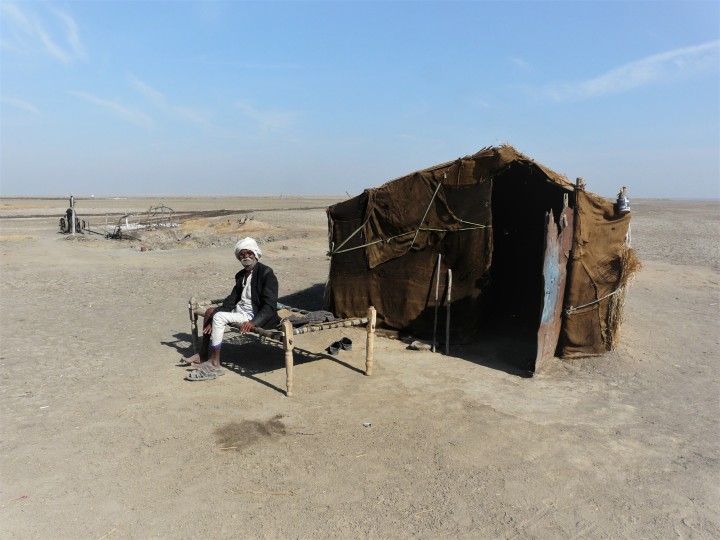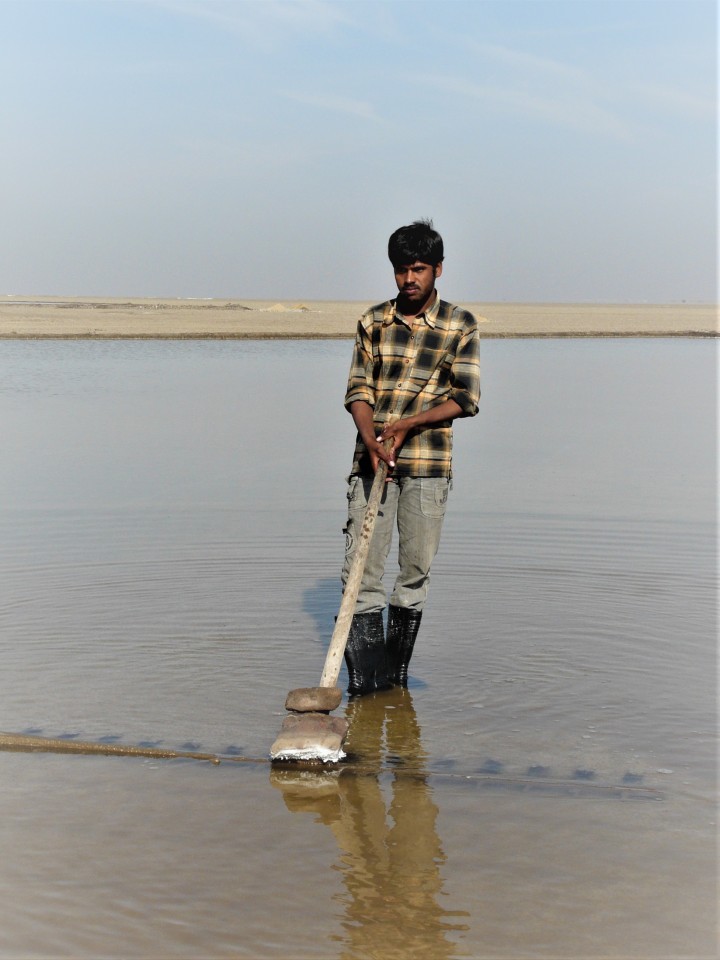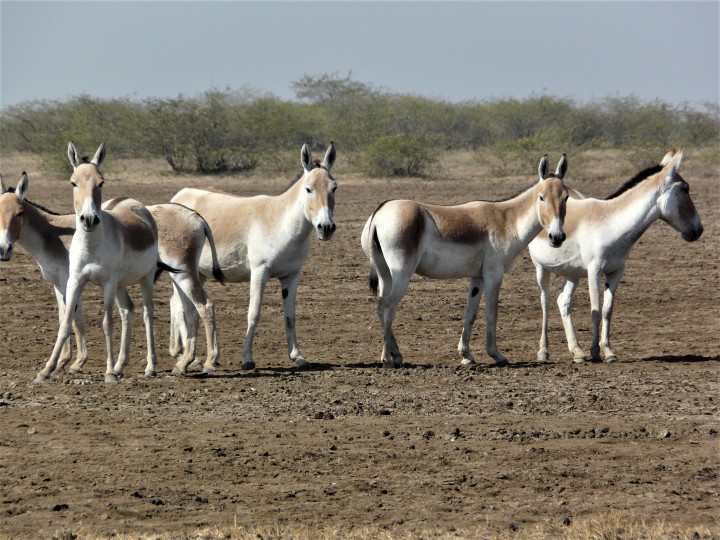The Little Raan, Gujarat, 2010.
The landscape in the Little Raan Sanctuary is harsh and extreme. For eight months of the year it’s a desert of cracked, crusty mud – a flat expanse of nothingness stretching as far as the eye can see. Confronted with such a landscape it’s easy to see how people believed it was possible to fall off the edge of the earth. Featureless, colourless, a country-scape to drive a person mad. Occasionally, a bet (elevated plateaus which rise to about three meters) provides eye candy. Heat mirages hover on the horizon. Vast lakes appear out of nowhere, shimmering in the sun’s glare. The emptiness is unrelenting.

Imagine living in such a place. The area is punctuated by desolate salt farms where Agarias – salt pan workers – belonging to the Chuwaliakolis caste (which comes under the backward classes) eke out a living by pumping up ground water and extracting the salt. They live in meagre huts, erected over pits dug in the ground to protect themselves from the wind and the sun. There is nothing, no water, no groceries, no school – just them, and the salt pans. They cannot return to their villages at the edge of the Little Raan; it’s essential that water keeps flowing through the salt pan without interruption so that the salt crystals are formed properly. The workers continuously pull huge wooden rakes through the water. It looked peaceful, almost serene, wide open space, huge skies and brilliant colour – but it’s easy to romanticise such things – the hands blister acutely and the whiteness of the salt can be blinding. Drinking water arrives every few days in a tanker – this water also has to be used for bathing – and of course, paid for. Food is sometimes brought by family members from the villages, but workers often don’t have fresh food.


Exploited by traders, salt workers are caught between a rock and a hard place. They are tied to merchants for getting loans and leases, buying diesel for their pumps and selling the salt. While Agarias sell their salt to the merchants for sixty paisa a kilo, merchants can sell it for Rs. 6 per kilo – a mark up of 1000 %. Agarias have no choice but to do this work – this is nothing else for them to do.



That is, until the monsoon transforms the Little Raan. For four months of the year, the desert becomes a seasonal wetland. The solid looking crust breaks open and becomes a sea. The area turns into a huge prawn fishing watery paradise. During this period, Agarias work on local farms. The Raan’s connection to the Gulf of Kutch make it a rich habitat for 975 species of water birds and 81 species of terrestrial birds. This is one of the few areas in the world where flamingos are known to breed naturally. It’s also home to the last surviving Asiatic wild ass or khur. The Khurs are beautiful animals, elegant, long legged, refined – much more horse than ass.

The Little Raan was declared a protected area in 1973, but this decision has not yet been implemented because the government has not yet settled the claims of the salt workers and fishermen. Until settlement is completed, the Forest Department cannot take measures to manage or protect the sanctuary. The problem of balancing the needs and livelihood of local people and protecting wildlife is a complex issue. Years of unregulated development in the Little Raan have taken their toll on the eco-system. Grazing animals and sheep encroach on the space where wildlife forages. Unregulated traffic (from the salt industry) has also disturbed wildlife. Gujarat is India’s largest salt producer and one third of the salt produced in Gujarat is made in the Little Raan. The rights of the salt workers cannot be ignored. The government has granted leases to societies, individuals, and companies to manufacture salt. Only salt workers holding leases issued before January 12 1973 will be considered legal while settling claims. A large minority considered ‘illegal’ will loose their only source of income.

An area of outstanding natural beauty, home to wolves, hyena, antelope, khur and countless birds, this sanctuary is also home to the 15,000 families engaged in salt mining and the 9,000 fisher men working in the prawn fishing industry. Is it possible to balance the needs of all?
Thanks for the tour and memories. We visited the Little Raan about five years ago.
LikeLike
Was the situation the same when you were there Peggy? I would like to know if things had changed since you were there five years after us…
LikeLike
Wow, so interesting. I have not seen salt mining like this before. It must be really tough for them.
LikeLiked by 1 person
Thanks for reading Lorelle. The environment was so tough. It must be a really hard life.
LikeLiked by 1 person
I love reading your stories. They are always so interesting and insightful. 😊
LikeLike
Thanks! What a nice thing to say.
LikeLike
Your pictures are striking. Were you part of a group, or exploring on your own?
LikeLike
Thanks. We were alone. We prefer to do our own thing and take our time.
LikeLiked by 1 person
Life for so many people is incredibly difficult. We are all a product of where we are born. If you are born into a salt mining family, this is what you do. Thanks for showing this area and the complicated story of human and wildlife.
LikeLike
There are so many times when I travel, that I’m so aware of this. And so thankful that I was born in the time and place I was.
LikeLike
My problems just got put into perspective. Thanks for sharing this story so elegantly.
LikeLike
I know it does make you feel like that, doesn’t it?!
LikeLiked by 1 person
These are such beautiful photos of a special place – yet the conditions of the workers are in stark contrast to this beauty, which is also subjective, of course. The desert is a tough place to live, for sure! Thanks for sharing this region with us – the facts, the memories, and the images. New information to me!
LikeLike
The Little Raan is a mix of so many things, totally unique and quite extraordinary. Lots of problems, but lots to appreciate as well. Thanks so much for taking the time to read and comment.
LikeLiked by 1 person